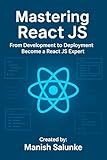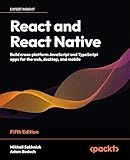Best Tools to Optimize React.js Performance to Buy in December 2025

Mastering React JS From Development to Deployment: Become React JS Expert



React and React Native: Build cross-platform JavaScript and TypeScript apps for the web, desktop, and mobile



Mastering Next.js 15: The Complete Guide to Building Modern Web Applications


To optimize performance in React.js applications, there are several practices you can follow.
- Use React.memo(): React.memo() is a higher-order component that can help in optimizing functional components by preventing unnecessary re-renders. It memorizes the component and only re-renders if the dependencies have changed.
- PureComponent: PureComponent is a base class for components that implements a shallow comparison of props and state. It automatically performs a shallow comparison and prevents re-renders if the props and state haven't changed. However, make sure the props and state are immutable to ensure proper performance gains.
- Use shouldComponentUpdate(): By implementing the shouldComponentUpdate() lifecycle method, you can control the conditions under which a component should update. Return false when unnecessary to avoid unnecessary re-renders.
- Virtualize large lists: For long lists, rendering all the items at once can impact performance. Virtualizing large lists allows rendering only the visible items and dynamically rendering the remaining items as the user scrolls.
- Memoize expensive computations: If you have expensive computations or heavy calculations within components, consider memoizing the results using tools like memoize-one or reselect. This avoids redundant computations during re-renders.
- Optimize DOM updates: Minimize the number of updates to the DOM by using efficient data structures and algorithms. Consider using optimized libraries like Immutable.js for managing immutable data structures.
- Use React Profiler: React Profiler is a built-in tool to track and optimize performance bottlenecks. It helps identify inefficient components or areas where rendering time can be reduced.
- Code splitting and lazy loading: Split your code into smaller chunks, and alternatively load them on-demand to prevent unnecessarily loading unused code. This can improve initial load times and reduce the overall bundle size.
- Use Production builds: Optimize your React.js application for production by building it with minification, bundling, and compression techniques. This reduces the bundle size and improves loading times.
- Performance testing and monitoring: Regularly test your application's performance and monitor it using tools like Lighthouse, Chrome DevTools, or performance profiling libraries. Identify any regressions or areas that require optimization.
Remember that performance optimization can vary depending on the specific needs and requirements of your application. It is crucial to profile and measure the impact of optimizations to ensure they are worth implementing.
What is React.memo and how can it be used for performance optimization?
React.memo is a higher-order component (HOC) that optimizes the rendering of functional components in React. It is used to memoize the result of a functional component's rendering, preventing unnecessary re-renders.
When a component is wrapped with React.memo(), it will only re-render if the props passed to it have changed. React.memo compares the previous and current props using a shallow equality check. If the props are the same, React.memo will return the memoized component, skipping the re-rendering process.
By using React.memo, you can avoid re-rendering components when the props haven't changed, which can significantly improve the performance of your React application. This is especially beneficial for large or complex components that might have expensive rendering operations.
Here's an example of using React.memo to optimize a functional component:
import React from 'react';
const MyComponent = React.memo(({ prop1, prop2 }) => { // Component rendering logic... });
export default MyComponent;
In the above example, the functional component MyComponent will only re-render if either prop1 or prop2 has changed. If the props remain the same, React.memo will return the memoized version of the component, preventing unnecessary rendering and improving performance.
It's important to note that React.memo should be used with caution. It is ideal for optimizing functional components that receive the same props and produce the same output given those props. However, it might not be suitable for all components, as it may introduce subtle bugs if used incorrectly. Carefully consider the requirements and behaviors of your component before applying React.memo for performance optimization.
What is the role of React Profiler in performance optimization?
The React Profiler is a built-in tool in React that helps in performance optimization by measuring the rendering time of each component in a React application. It provides detailed information about how long it takes to render a component, how many times it renders, and which components contribute the most to the overall rendering time.
The role of the React Profiler in performance optimization is to identify performance bottlenecks in the application. It helps developers pinpoint components that are rendering too frequently or taking longer to render than expected. By analyzing the data provided by the Profiler, developers can focus on optimizing these specific components to improve the overall performance of the application.
The React Profiler also helps in identifying unnecessary re-renders or inefficient rendering patterns. By understanding when and why components are re-rendering, developers can optimize the application by implementing techniques such as memoization, shouldComponentUpdate, or using React memo or PureComponent. This can reduce unnecessary rendering and improve the performance of the application.
In summary, the React Profiler plays a vital role in performance optimization by providing insights into component rendering times, helping developers identify performance bottlenecks, and guiding them in optimizing the application for better performance.
How to optimize animations and transitions in React.js?
There are several ways to optimize animations and transitions in React.js. Here are some strategies you can follow:
- Use CSS Transitions and Animations: CSS transitions and animations are usually hardware-accelerated, which makes them highly performant. Utilize CSS properties like transform and opacity to create smooth animations.
- Use requestAnimationFrame: Instead of relying on setTimeout or setInterval for timing, use the requestAnimationFrame API. It synchronizes with the browser's frame rendering and improves performance by reducing the number of unnecessary repaints.
- Debounce or throttle events: If your animations are triggered by user interaction or events, consider debouncing or throttling those events. This helps prevent unnecessary re-renders and reduces the workload on the browser.
- Implement shouldComponentUpdate: Use the shouldComponentUpdate lifecycle method to optimize rendering. By avoiding unnecessary updates, you can improve performance.
- Use React's TransitionGroup and CSSTransition components: These components, provided by the react-transition-group library, are specifically designed to optimize and manage animations and transitions in React applications.
- Leverage CSS property optimization: Optimize your CSS properties to ensure minimal repaints and reflows. Avoid animating expensive properties like box-shadow or width, and prefer using transform and opacity instead.
- Avoid overusing heavy animations: Fancy and complex animations can be resource-intensive. Use animations judiciously and only when necessary to avoid overwhelming the browser's rendering capability.
- Use performance analysis tools: Tools like React Profiler, Chrome DevTools, or Visual Studio Code's Performance tab can help you analyze and identify any bottlenecks in your animations or transitions.
- Test on real devices and slow connections: Optimize and test your animations on real devices and slow network connections to ensure smooth performance across a variety of environments.
By following these strategies, you can optimize animations and transitions in React.js applications for better performance and user experience.
What is the role of memoization in React.js performance optimization?
Memoization is a technique used in React.js performance optimization to improve the efficiency of rendering components. It involves caching the results of expensive function calls and reusing them if the inputs to the function remain the same.
In React, components re-render whenever the state or props change. However, sometimes the inputs to a component remain the same, resulting in unnecessary re-execution of functions and rendering. Memoization helps prevent this by storing the computed output of a function in memory based on its inputs.
By memoizing functions using techniques like "useCallback" or "memo", React can detect whether the inputs to a component have changed and decide whether to re-render or not. This can significantly optimize performance, especially in scenarios where expensive computations or rendering tasks occur frequently.
Memoization can be particularly useful when dealing with large component trees or computing values that don't change often. It helps reduce the number of calculations and renders, resulting in faster application performance and improved user experience.
How to monitor performance metrics of a React.js app?
Monitoring performance metrics in a React.js app is important to ensure that the application runs smoothly and efficiently. Here are some ways to monitor performance metrics in a React.js app:
- React DevTools: React DevTools is a browser extension that provides a set of development and debugging tools specifically for React applications. It allows you to inspect component hierarchies, view state and props, and monitor performance. You can use the Profiler feature in React DevTools to measure the rendering performance of your components and identify any bottlenecks.
- Performance API: The Performance API provides a set of methods and properties to measure the performance of your app. You can use the performance.now() method to measure the time it takes for specific operations or functions to execute. By measuring the time before and after a certain operation, you can calculate the elapsed time and identify any performance issues.
- Logging and Error Reporting: Implement logging and error reporting in your React app to capture any performance-related errors or exceptions. Services like Sentry, LogRocket, or New Relic can be integrated into your app to collect performance-related data and provide insights into potential issues.
- Network Monitoring: Use network monitoring tools like Chrome DevTools or tools like Lighthouse to analyze your app's network performance. You can monitor network requests, identify slow requests, and optimize them accordingly.
- Performance Testing: Implement performance testing using tools like WebPagetest or Lighthouse CI to regularly assess your React app's performance. These tools can measure factors like page load time, first meaningful paint, and other important metrics.
- User Monitoring: Collect and analyze user behavior and performance metrics using tools like Google Analytics or Hotjar. These tools can help you understand how users interact with your app and identify any areas that need further optimization.
By using the above approaches, you can gain insights into the performance of your React.js app and identify areas for improvement, ultimately ensuring a better user experience.
